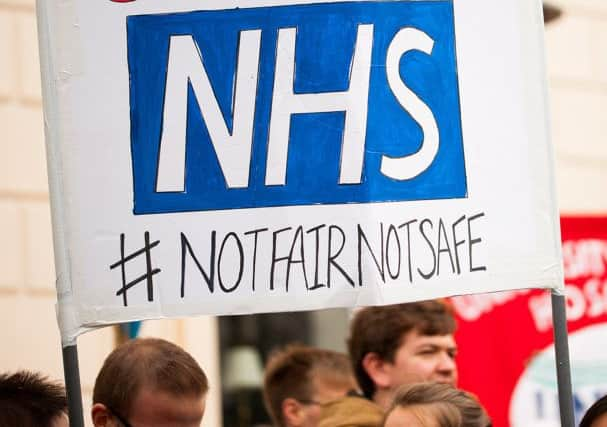The Great NHS Gamble: Northamptonshire will see funding drop by £328 per head over next five years


Across the UK, nearly 20 hospitals are marked for closure and care from cradle to grave is set to be put through a wholesale overhaul to plug a £22bn black hole in health service funding, an investigation by Johnston Press can reveal.
An analysis of the 44 regional blueprints drawn up by health service leaders to remodel the NHS in England - a process which critics complain has largely bypassed patients - has revealed for the first time the extent of the cuts and drastic changes in the delivery of care that the Government wants to achieve by March 2021.
Advertisement
Hide AdAdvertisement
Hide AdDoctors’ leaders have told this paper that the NHS is being “deliberately underfunded” and the changes amount to a charter for cuts and creeping privatisation which together pose a threat to the founding ideals of a free at the point of delivery health service.


Known as Sustainability and Transformation Plans (STPs), they represent the fruit of more than a year of consultations between more 440 NHS organisations and 152 local authorities. But despite a timetable that is due to see them finalised by April, with far-reaching consequences for some 55 million people, the documents are almost unknown to the public.
One survey last month found that six out of seven people have never heard of the STPs, prompting warnings to that the shake up is being pushed through without meaningful consultation or consent. Campaigners have told this paper that they also have serious concerns about the legality of the blueprints.
The sweeping changes to balance the books of a health service struggling to cope with its worst winter crisis in more than a decade brought accusations from doctors’ leaders that they amount to a ploy to hollow out the NHS while shifting blame away from ministers on to health service chiefs.
Advertisement
Hide AdAdvertisement
Hide AdDr Mark Porter, chairman of the British Medical Association, which represents more than 150,000 doctors, told us: “We are being asked for too much and are being deliberately underfunded. What this means is our inability to deliver on our promise to patients of a comprehensive service that meets the needs of everyone, when they need it, free of charge.


“We have increased numbers of patients while resources are not rising in the same way. They are deliberately cutting into the service we provide rather than streamlining services. What is being asked goes far beyond efficiency savings and dips into the area of cuts.”
At the heart of the 44 blueprints is a strategy to move the fulcrum of the NHS away from hospitals to a new set of community services integrated with social care.
Analysis of the documents shows that specialist care from stroke services to major trauma will be in many cases centralised to fewer units, where research suggests the results for patients can be improved despite longer journeys.
Advertisement
Hide AdAdvertisement
Hide AdHowever, what new information the lengthy yet opaque plans reveal is debatable.


Until their recent release, the plans were a closely guarded secret with health chiefs instructing managers to keep draft details out of the public domain to prevent “politically sensitive” changes from leaking out. But the final documents are in some cases so riddled with jargon, vague assertions and re-announced projects that clinicians and politicians have said the impact of the plans is unknown.
In Northamptonshire :
*The county will need to find £320 million worth of savings to balance the books by 2021.
*That means funding will drop by £328 per head.


*The county will require 283 new hospital beds to meet demand by 2021 - to take an extra 22,000 more admissions.
Advertisement
Hide AdAdvertisement
Hide Ad*It will need to recruit 150 new GP’s by 2021, with the county’s doctors likely to deal with 578,830 more appointments each year.
*By 2021, Northamptonshire will have 2,452 new social care requests as the population expands, and ages.
*A major investment is planned in “out of hospital services” and GP practices are set to be merged.
*Special ties such as dermatology, rheumatology and musculoskeletal services are set to be moved to a single hospital site, with similar possible plans for up to seven other specialist services.
Advertisement
Hide AdAdvertisement
Hide Ad*A modular hospital building could be built in the Northampton General Hospital’s car park to meet beds demand.


The STPs make clear such changes cannot be brought about without significant changes to hospital provision, including closures.
In South West London, where one of five major acute hospitals is marked for closure, the STP makes its case bluntly. It states: “Clinicians do not believe that we will be able to recruit or pay for sufficient workforce to deliver seven-day services at five acute sites.”
Community hospital provision is also facing significant reductions with plans for the closure or redesignation of sites from Cumbria to Devon.
Advertisement
Hide AdAdvertisement
Hide AdCampaigners argue the end result will be a move to a health insurance-based model of care. Deborah Harrington of the National Health Action Party, said: “The STP plans are pushing the NHS into the US model of ‘medicare’. We will have fewer hospitals and reduced access to qualified staff. The NHS will become a provider of last resort.”
The plans to change to a health service focused on preventing serious illness and moving care into the community while centralising services in acute hospitals have also received backing from clinicians and policy makers.
The left-leaning IPPR think-tank said many of the reforms proposed in the STPs “deserve a fair hearing” while at the same time calling on the Government to close the NHS funding gap by creating a ring-fenced “NHS tax” funded by a 1p rise in National Insurance.
A poll for Sky News last week found that 68 per cent of people would support such a tax rise, with a similar proportion arguing that the NHS is getting worse.
Advertisement
Hide AdAdvertisement
Hide AdHarry Quilter-Pinner, a health specialist at the IPPR, said: “There is a funding crisis in the NHS and the answer to that is not a return to the original model of the health service with extra money.
“There is evidence that treatment can be moved nearer to home and improve access and quality of life for patients. Despite the opposition that hospital reforms generate, nobody really wants to spend time on them. But these changes must be funded and the Government should support STP leaders rather than play a blame game with those in charge of the NHS.”
NHS England has set April as the deadline for its transformation plans to be finalised but those who work for it warn the STPs amount to a “gamble” with the service’s future.
Dr David Wrigley, a Lancashire GP, said: “All the STPs are doing is moving the deckchairs around on the Titanic and they are not going to resolve the current crisis facing the NHS. There is a real gamble being taken with the NHS as these plans keep talking about moving care from hospitals into the community. But problem is there is no leeway - social care is collapsing, general practice is on its knees and that’s all on top of the hospital service being in meltdown.” A Department of Health spokesperson said: “We are committed to the NHS — that’s why we have invested £10 billion in its own plan to transform services and improve standards of care, including almost £4 billion this year.
Advertisement
Hide AdAdvertisement
Hide Ad“NHS England are introducing Sustainability and Transformation Plans to help ensure the best standards of care, with local doctors, hospitals and councils working together in conjunction with local communities for the first time.”
Our findings include:
:: The proposed or likely closure of 19 hospitals, including five major acute hospitals.
:: The closure of more than 2,000 beds in acute and community hospitals and the loss of nearly 3,000 jobs to create a “smaller, more agile” workforce.
:: Major re-organisations of emergency and maternity care.
:: A massive move to “out-of-hospital” care with patients encouraged to manage their own health needs, aided by technology which may include “virtual doctors”.
Advertisement
Hide AdAdvertisement
Hide Ad::Primary care “hubs” will bring health services closer to home - in one case potentially using libraries to see patients.
:: Hundreds of millions of pounds are to be saved by cutting prescription costs and in some cases rationing care or operations. In north east London, managers are considering a rule that specialist beds are restricted to those who require a minimum stay of 48 hours.
:: A drastic reduction in face-to-face outpatient appointments with doctors using video links to assess and discharge patients.
:: A wildly-varying deficit per head of population. In the Durham, Darlington and Tees area the amount that needs to be saved by 2021 is £216 per capita but in Surrey Heartlands the amount is more than triple at £768.
Advertisement
Hide AdAdvertisement
Hide AdA map of the key findings can be viewed here: https://www.google.com/maps/d/edit?mid=1_h20cOSEz_AJw17-xyWMwTWZnkc&ll=52.688868191221886%2C-2.0141618999999764&z=7
Download our app by clicking here to download from Google Play or clicking here to download from Apple’s App Store.